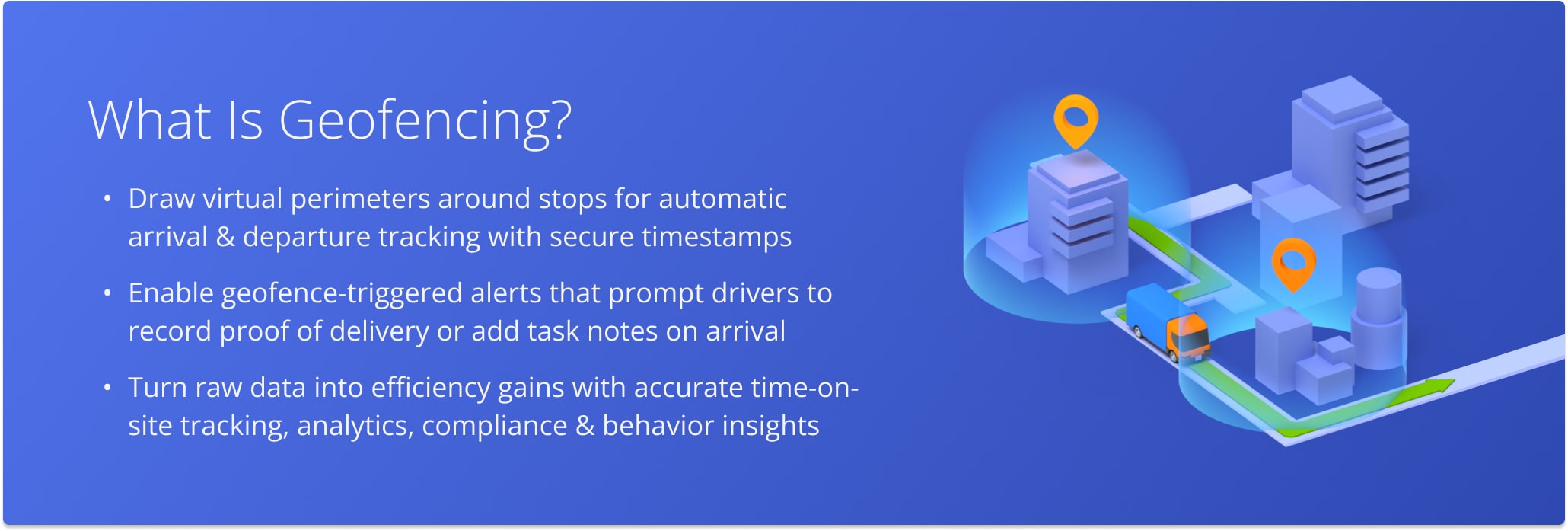What Is Geofencing?
Geofencing is the process of setting up virtual perimeters around geographical areas on a map for various tracking purposes. That’s why geofencing is often used in route planning and route optimization. Fleet managers can set geofences around the route destinations that the delivery drivers need to visit and service. This automates tracking processes and minimizes human errors.
Table of Contents
What Is a Geofence?
A geofence is a virtual perimeter that you can set around a customer address or other location on a map. Logistics professionals use geofences for multiple delivery driver tracking purposes as a part of the geofencing activity. Moreover, geofences can be adjusted to fit specific shapes and sizes. Thereby, customizable geofences allow users to accommodate business-specific tracking needs.
How Does Geofencing Work?
Geofencing can be leveraged with GPS and RFID-powered (Radio Frequency Identification) hardware and route planning software solutions. Here’s how geofencing works:
- A fleet manager defines a virtual perimeter around a particular address or location using GPS-enabled software.
- The designated driver has a GPS-enabled device or mobile app connected to the enterprise route dispatch software solution that the manager uses.
- While driving a dispatched route, the driver enters the virtual geofence set up around the customer location.
- Upon entering or leaving the given geofence, the driver triggers one or multiple automated processes, like creating arrival time stamps, sending an SMS message to the customer, etc.
For example, Route4Me uses geofencing for such things as automated visitation and departure timestamps, automated customer SMS notifications, triggering action in mobile apps like opening notes, etc.
Geofencing can help you track your drivers and identify delays, missed visitations, suspiciously short service time, unscheduled breaks, etc. You can also save time by automating the check-in and check-out processes, which can take approximately one hour per day for each driver.
Geofencing Example
To better understand how geofencing technology works, here’s an example:
- Let’s say you have to create a multi-stop route with 10 addresses for a single driver, and you want to know how long it will take the driver to service each stop.
- You set up a virtual geofence around each customer address on that route.
- Whenever the driver enters a geofenced area, the system will create the corresponding entry timestamp that can be checked from the Web.
- When the driver services the address and sets off for the next customer, a departure timestamp will be created. This information will allow you to check when and if the driver arrived and left the location. Plus, the difference between the two will also tell you how long the driver stayed on site.
- This will continue until the driver services all customers on the route. At the end of the route, you’ll know the average time your driver spends to service an address.
Geofencing has multiple applications in last mile delivery, fleet management, route planning, and even marketing. For example, Uber sets geofences around hotels and airports to target people most likely to need a ride.
Visit Route4Me's Marketplace to Check out Associated Modules:
- Notifications & Alerts
Customer Email and SMS Alerting and Notifications - Geofence Entered
- Notifications & Alerts
Customer Email and SMS Alerting and Notifications - Geofence Left
- Operations
Audit Logging and Activity Stream
Last Updated:
